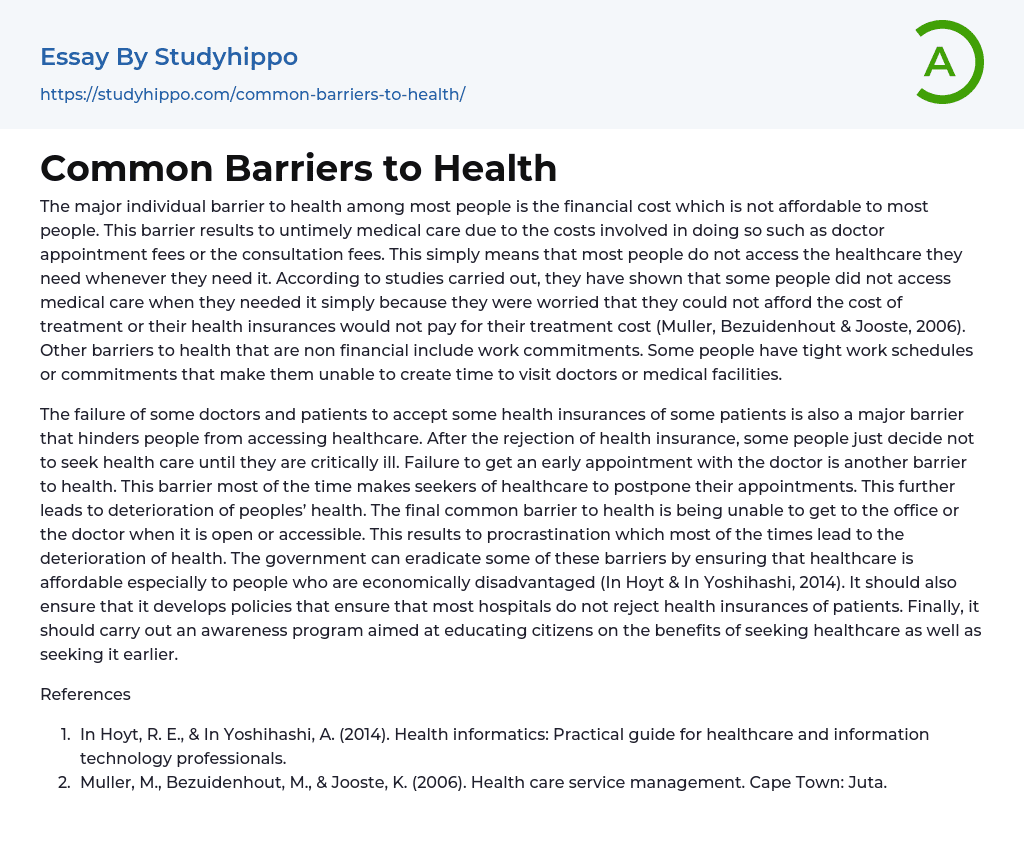The major individual barrier to health among most people is the financial cost which is not affordable to most people.
This barrier results to untimely medical care due to the costs involved in doing so such as doctor appointment fees or the consultation fees. This simply means that most people do not access the healthcare they need whenever they need it. According to studies carried out, they have shown that some people did not access medical care when they needed it simply because they were worried that they could not afford the cost of treatment or their health insurances would not pay for their treatment cost (Muller, Bezuidenhout & Jooste, 2006). Other barriers to health that are non financial include work commitments. Some people have tight work schedules or commitments that make them unable to create time to visit doctors or
...medical facilities. The failure of some doctors and patients to accept some health insurances of some patients is also a major barrier that hinders people from accessing healthcare.
After the rejection of health insurance, some people just decide not to seek health care until they are critically ill. Failure to get an early appointment with the doctor is another barrier to health. This barrier most of the time makes seekers of healthcare to postpone their appointments. This further leads to deterioration of peoples’ health. The final common barrier to health is being unable to get to the office or the doctor when it is open or accessible. This results to procrastination which most of the times lead to the deterioration of health.
The government can eradicate some of these barriers by ensuring that healthcare is affordable especiall
to people who are economically disadvantaged (In Hoyt & In Yoshihashi, 2014). It should also ensure that it develops policies that ensure that most hospitals do not reject health insurances of patients. Finally, it should carry out an awareness program aimed at educating citizens on the benefits of seeking healthcare as well as seeking it earlier.
References
- In Hoyt, R. E., & In Yoshihashi, A. (2014). Health informatics: Practical guide for healthcare and information technology professionals.
- Muller, M., Bezuidenhout, M., & Jooste, K. (2006). Health care service management. Cape Town: Juta.
- Anatomy and Physiology essays
- Addiction essays
- Biodegradation essays
- Dental Care essays
- Disease essays
- Disorders essays
- Health Care essays
- Intelligence Quotient essays
- Nutrition essays
- Olfaction essays
- Public Health essays
- Women's Health essays
- World health organization essays
- Cancer essays
- Infectious Disease essays
- Lung Cancer essays
- Neurology essays
- Physical Exercise essays
- Medicine essays
- Sex essays
- Inquiry essays
- Disability essays
- Poison essays
- Action Potential essays
- Nervous System essays
- Childbirth essays
- Puberty essays
- Blood essays
- Kidney essays
- Neuron essays
- Body essays
- Glucose essays
- Sense essays
- Heart essays
- Skeleton essays
- Human Physiology essays
- Eye essays
- Immune System essays
- Muscle essays
- Skin essays
- Brain essays
- Central Nervous System essays
- Human Skin Color essays
- Digestive System essays
- Common sense essays
- Respiration essays
- alcoholism essays
- Smoking essays
- Casino essays
- Tobacco essays




